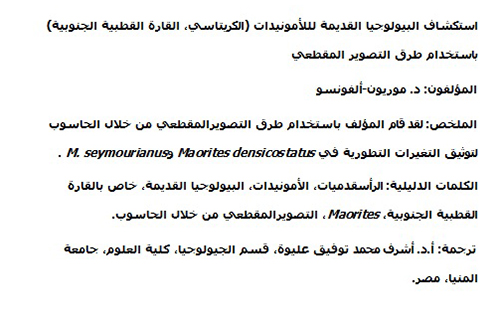Exploring the paleobiology of ammonoids (Cretaceous, Antarctica) using non-invasive imaging methods
Plain Language Abstract
Ammonoids are an important group of extinct cephalopods that inhabited the oceans from the Early Devonian to the end of the Cretaceous period (407-65 Ma). These animals possessed a complex chambered shell comparable to the modern Nautilus, whose principal functions were protection (against predators and hydrostatic pressure), and buoyancy. Nonetheless, there are still open questions about the ammonoid shell that intrigue researchers, such as the detailed function of several shell components (functional morphology), the transformations that are expressed during growth (ontogenetic variation), and the morphological differences between members of the same species (intraspecific variation). These are important subjects to better understand the taxonomy and evolution of the group. With the application of modern techniques such as computed tomography (CT), researchers have the opportunity to study these aspects of the ammonoid conch without destroying the sample. Here employing medical CT scanners, I explore the paleobiology of ammonoids from Cretaceous deposits of Antarctica. The results show that there are significant changes in conch morphology during the ontogeny of these organisms, and elucidate the differences between the studied species. Based on the results, an evolutionary mechanism is proposed for the evolution of these ammonoids and other uses for the methodology are suggested.
Resumen en Español
Explorando la paleobiología de amonoideos (Cretácico, Antártida) usando métodos de imagen no invasivos
En base a información obtenida a través de tomografía computada médica, documento los cambios ontogenéticos en la morfología de la conchilla de Maorites densicostatus y M. seymourianus. Con este propósito, se midieron 20 especímenes en pasos de 30º comenzando por un diámetro de conchilla de 10 mm, para obtener las trayectorias ontogenéticas de varios parámetros conchiles. Los resultados muestran que cuatro parámetros, la altura de la abertura, la altura de la vuelta, el ancho de la vuelta y el ancho umbilical, tienen una baja variación y pueden ser fácilmente modelados. En contraste, los índices derivados y las tasas de expansión de vuelta muestran una alta variación, y sus trayectorias ontogenéticas pueden ser categorizadas en dos estadíos: el primero, se identifica por un cambio morfológico rápido (Perlatum stage), seguido por un segundo estadío que muestra una morfología de conchilla estable (Gibbosum stage). Más aún, las trayectorias ontogenéticas revelaron que en la adultez, M. densicostatus exhibe morfologías similares a los juveniles y subadultos de M. seymourianus. Este fenómeno podría indicar un posible cambio heterocrónico basado en el tamaño (pedomorfismo) como un posible mecanismo evolutivo.
Palabras clave: Cephalopoda; amonoideos; palaeobiología; Antártida; Maorites; tomografía computada
Traducción: Diana Elizabeth Fernández
Résumé en Français
Explorer la paléobiologie des ammonoïdes du Crétacé d’Antarctique par des méthodes d’imagerie non invasives
D’après des données de tomodensitométrie médicale (CT), je documente dans cet article les changements ontogénétiques de la morphologie de la coquille de Maorites densicostatus et M. seymourianus. Dans cette optique, 20 spécimens ont été mesurés avec des pas de 30° en commençant avec une coquille d’un diamètre de 10 mm, pour obtenir les trajectoires ontogénétiques de plusieurs paramètres de la coquille. Les résultats montrent que quatre paramètres morphologiques (la hauteur de l’ouverture, la hauteur de la spire, la largeur de la spire, et la largeur de l’ombilic) ont une variation faible et peuvent être facilement modélisés. En revanche, les indices qui en dérivent et les taux d’expansion de la spire montrent une grande variation et leurs trajectoires ontogénétiques peuvent être catégorisées en deux stades : le premier stade est identifié par un changement morphologique rapide (stade Perlatum), suivi par un second stade montrant une morphologie de la coquille stable (stade Gibbosum). De plus, les trajectoires ontogénétiques révèlent qu’à l’âge adulte, M. densicostatus montre des morphologies similaires à celles des spécimens juvéniles et subadultes de M. seymourianus. Ce phénomène pourrait indiquer un décalage hétérochronique basé sur la taille (pédomorphose) comme possible mécanisme évolutif.
Mots-clés : Cephalopoda ; ammonoïdes ; paléobiologie ; Antarctique ; Maorites ; tomodensitométrie
Translator: Antoine Souron
Deutsche Zusammenfassung
Erforschung der Paläobiologie von Ammonoideen (Kreide, Antarktis) mit nicht-invasiven Bildgebungsverfahren
Basierend auf medizinischen Daten der Computertomographie (CT) dokumentiere ich hier die ontogenetischen Veränderungen der Gehäusemorphologie von Maorites densicostatus und M. seymourianus. Zu diesem Zweck wurden 20 Proben in 30°-Schritten ab einem Schalendurchmesser von 10 mm gemessen, um die ontogenetischen Trajektorien mehrerer Gehäuseparameter zu erhalten. Die Ergebnisse zeigen, dass vier morphologische Parameter, die Öffnungshöhe, die Wirbelhöhe, die Wirbelbreite und die Nabelbreite eine geringe Variation aufweisen und leicht modelliert werden können. Im Gegensatz dazu zeigen abgeleitete Indizes und Wirbelausdehnungsraten eine hohe Variation, und ihre ontogenetischen Trajektorien können in zwei Stufen kategorisiert werden: die erste Stufe ist durch eine schnelle morphologische Veränderung gekennzeichnet (Perlatum-Stadium), in der zweiten Stufe folgt eine stabile Gehäusemorphologie (Gibbosum-Stadium). Darüber hinaus zeigten die ontogenetischen Trajektorien, dass M. densicostatus im Erwachsenenalter ähnliche Morphologien wie juvenile und subadulte Stadien von M. seymourianus aufweist. Dieses Phänomen könnte auf eine mögliche größenbasierte heterochrone Verschiebung (Pädomorphose) als möglichen evolutionären Mechanismus hinweisen.
Schlüsselwörter: Cephalopoda; Ammonoideen; Paläobiologie; Antarktis; Maorites; Computertomographie.
Translator: Eva Gebauer
Arabic

Translator: Ashraf M.T. Elewa
Polski
Badanie paleobiologii amonoidów (kreda, Antarktyda) przy użyciu nieinwazyjnych metod obrazowania
W oparciu o dane z medycznej tomografii komputerowej (CT), dokumentuję zmiany ontogenetyczne w morfologii muszli Maorites densicostatus i M. seymourianus. W tym celu zmierzono 20 próbek w krokach co 30°, zaczynając od średnicy skorupy 10 mm, aby uzyskać ontogenetyczne trajektorie kilku parametrów muszli. Wyniki wskazują, że cztery parametry morfologiczne, wysokość otworu, wysokość skrętu, szerokość skrętu i szerokość pępka różnią się w niewielkim stopniu i można je łatwo modelować. Natomiast wyprowadzone wskaźniki i szybkości ekspansji okrężnej wykazują dużą zmienność, a ich trajektorie ontogenetyczne można podzielić na dwa etapy: pierwszy charakteryzuje się szybką zmianą morfologiczną (etap Perlatum), drugi wykazuje stabilną morfologię muszli (etap Gibbosum). Co więcej, trajektorie ontogenetyczne ujawniły, że w wieku dorosłym M. densicostatus wykazuje podobną morfologię jak młode i prawie dorosłe M. seymourianus. Zjawisko to może wskazywać na możliwe przesunięcie heterochroniczne oparte na wielkości (pedomorfoza) jako możliwy mechanizm ewolucyjny.
Słowa kluczowe: Cephalopoda; amonoidy; paleobiologia; Antarktyda; Maorites; tomografia komputerowa.
Translator: Krzysztof Stefaniak

